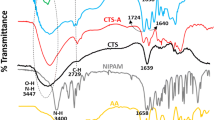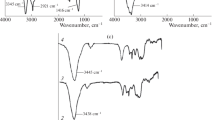Abstract
In this study, new pH-sensitive nanogels containing rivastigmine as a model drug were synthesized by graft polymerization of Acrylamid/Sodium Acrylate monomers onto chitosan (CS) and kappa-carrageenan (CG or κ-carrageenan) backbone in the presence of N, N'-Methylenebisacrylamide (MBA) as cross-linker, nitrogen-doped carbon dots (N-CDs) and ammonium persulfate as an initiator. The prepared nanogels were characterized by FE-SEM, XRD, FTIR, EDX and TGA techniques. The swelling behavior of the nanogels was affected by MBA content, monomer content, amount of CG or CS, and pH in the synthesis. The nanogels exhibited well pH-sensitivity during drug release investigation under simulated gastric (< 61% at pH 1.2) and intestinal (~ 95% at pH 7.4) media. The cytotoxicity test was investigated on human fibroblast cells using MTT assay. The results indicated that cell survival rate was more than 88% in < 62.5 μg/mL concentration of nanogels. Incorporating of N-CDs in the nanogel network increased the swelling capacity, entrapment efficiency, and ensuring the controlled release of the entrapped drug. In this work, we were able to enhance the properties of drug-loaded chitosan nanogels in pH 7.4.
Graphic abstract








Similar content being viewed by others
References
Wang H, Ke F, Mararenko A, Wei Z, Banerjee P, Zhou S (2014) Responsive polymer–fluorescent carbon nanoparticle hybrid nanogels for optical temperature sensing, near-infrared light-responsive drug release, and tumor cell imaging. Nanoscale 6(13):7443–7452. https://doi.org/10.1039/C4NR01030B
Rashidzadeh A, Olad A, Hejazi MJ (2017) Controlled release systems based on intercalated paraquat onto montmorillonite and clinoptilolite clays encapsulated with sodium alginate. Adv Polym Technol 36(2):177–185. https://doi.org/10.1002/adv.21597
Rashidzadeh A, Olad A, Salari D, Reyhanitabar A (2014) On the preparation and swelling properties of hydrogel nanocomposite based on sodium alginate-g-poly (acrylic acid-co-acrylamide)/clinoptilolite and its application as slow release fertilizer. J Polym Res 21(2):344. https://doi.org/10.1007/s10965-013-0344-9
Badakhshanian E, Hemmati K, Ghaemy M (2016) Enhancement of mechanical properties of nanohydrogels based on natural gum with functionalized multiwall carbon nanotube: study of swelling and drug release. Polymer 90:282–289. https://doi.org/10.1016/j.polymer.2016.03.028
Dash R, Foston M, Ragauskas AJ (2013) Improving the mechanical and thermal properties of gelatin hydrogels cross-linked by cellulose nanowhiskers. Carbohydr Polym 91(2):638–645. https://doi.org/10.1016/j.carbpol.2012.08.080
Yang Y, Hu Q, Zhang Q, Jiang K, Lin W, Yang Y, Cui Y, Qian G (2016) A large capacity cationic metal–organic framework nanocarrier for physiological pH responsive drug delivery. Mol Pharm 13(8):2782–2786. https://doi.org/10.1021/acs.molpharmaceut.6b00374
Mahdavinia GR, Rahmani Z, Karami S, Pourjavadi A (2014) Magnetic/pH-sensitive κ-carrageenan/sodium alginate hydrogel nanocomposite beads: preparation, swelling behavior, and drug delivery. J Biomater Sci Polym Ed 25(17):1891–1906. https://doi.org/10.1080/09205063.2014.956166
Azhar FF, Shahbazpour E, Olad A (2017) pH sensitive and controlled release system based on cellulose nanofibers-poly vinyl alcohol hydrogels for cisplatin delivery. Fibers Polym 18(3):416–423. https://doi.org/10.1007/s12221-017-6958-5
Posocco B, Dreussi E, De Santa J, Toffoli G, Abrami M, Musiani F, Grassi M, Farra R, Tonon F, Grassi G (2015) Polysaccharides for the delivery of antitumor drugs. Materials 8(5):2569–2615. https://doi.org/10.3390/ma8052569
Wang X, Cao L, Lu F, Meziani MJ, Li H, Qi G, Zhou B, Harruff BA, Kermarrec F, Sun Y-P (2009) Photoinduced electron transfers with carbon dots. Chem Comm 25:3774–3776. https://doi.org/10.1039/B906252A
Yang S-T, Cao L, Luo PG, Lu F, Wang X, Wang H, Meziani MJ, Liu Y, Qi G, Sun Y-P (2009) Carbon dots for optical imaging in vivo. J Am Chem Soc 131(32):11308–11309. https://doi.org/10.1021/ja904843x
Nie H, Li M, Li Q, Liang S, Tan Y, Sheng L, Shi W, Zhang SX-A (2014) Carbon dots with continuously tunable full-color emission and their application in ratiometric pH sensing. Chem Mater 26(10):3104–3112. https://doi.org/10.1021/cm5003669
Jelinek R (2017) Bioimaging applications of carbon-dots. In: Araujo P (ed) Carbon quantum dots. Springer, Tuscaloosa, AL, pp 61–70
Shen J, Shang S, Chen X, Wang D, Cai Y (2017) Highly fluorescent N, S-co-doped carbon dots and their potential applications as antioxidants and sensitive probes for Cr (VI) detection. Sens Actuators B Chem 248:92–100. https://doi.org/10.1016/j.snb.2017.03.123
Chen P, Wang F, Chen Z-F, Zhang Q, Su Y, Shen L, Yao K, Liu Y, Cai Z, Lv W (2017) Study on the photocatalytic mechanism and detoxicity of gemfibrozil by a sunlight-driven TiO 2/carbon dots photocatalyst: The significant roles of reactive oxygen species. Appl Catal B Environ 204:250–259. https://doi.org/10.1016/j.apcatb.2016.11.040
Yuan F, Wang Z, Li X, Li Y, Tan ZA, Fan L, Yang S (2017) bright multicolor bandgap fluorescent carbon quantum dots for electroluminescent light-emitting diodes. Adv Mater 29(3):1604436. https://doi.org/10.1002/adma.201604436
Li X, Rui M, Song J, Shen Z, Zeng H (2015) Carbon and graphene quantum dots for optoelectronic and energy devices: a review. Adv Funct Mater 25(31):4929–4947. https://doi.org/10.1002/adfm.201501250
Wang Q, Huang X, Long Y, Wang X, Zhang H, Zhu R, Liang L, Teng P, Zheng H (2013) Hollow luminescent carbon dots for drug delivery. Carbon 59:192–199. https://doi.org/10.1016/j.carbon.2013.03.009
Bhunia SK, Saha A, Maity AR, Ray SC, Jana NR (2013) Carbon nanoparticle-based fluorescent bioimaging probes. Sci Rep 3:1473–1479. https://doi.org/10.1038/srep01473
Hu S, Zhao Q, Dong Y, Yang J, Liu J, Chang Q (2013) Carbon-dot-loaded alginate gels as recoverable probes: Fabrication and mechanism of fluorescent detection. Langmuir 29(40):12615–12621. https://doi.org/10.1021/la402647t
Zhou L, Lin Y, Huang Z, Ren J, Qu X (2012) Carbon nanodots as fluorescence probes for rapid, sensitive, and label-free detection of Hg 2+ and biothiols in complex matrices. Chem Commun 48(8):1147–1149. https://doi.org/10.1039/C2CC16791C
Khlebtsov N, Dykman L (2011) Biodistribution and toxicity of engineered gold nanoparticles: a review of in vitro and in vivo studies. Chem Soc Rev 40(3):1647–1671. https://doi.org/10.1039/C0CS00018C
Majumdar S, Krishnatreya G, Gogoi N, Thakur D, Chowdhury D (2016) Carbon-dot-coated alginate beads as a smart stimuli-responsive drug delivery system. ACS Appl Mater 8(50):34179–34184. https://doi.org/10.1021/acsami.6b10914
Rahmani Z, Ghaemy M (2019) One-step hydrothermal-assisted synthesis of highly fluorescent N-doped carbon dots from gum tragacanth: Luminescent stability and sensitive probe for Au3+ ions. Opt Mater 97:109356. https://doi.org/10.1016/j.optmat.2019.109356
Rahmani Z, Sahraei R, Ghaemy M (2018) Preparation of spherical porous hydrogel beads based on ion-crosslinked gum tragacanth and graphene oxide: Study of drug delivery behavior. Carbohydr Polym 194:34–42. https://doi.org/10.1016/j.carbpol.2018.04.022
Patel KC, Goli D (2016) Formulation preparation, characterization, optimization, behavior and histological evaluation of brain hippocampus for brain targeted PLGA-Soya lecithin-tween 80 nanoparticles in an Alzheimer’s disease model. Der Pharm Lett 8(1):102–120
Hosseini MS, Hemmati K, Ghaemy M (2016) Synthesis of nanohydrogels based on tragacanth gum biopolymer and investigation of swelling and drug delivery. Int J Biol Macromol 82:806–815. https://doi.org/10.1016/j.ijbiomac.2015.09.067
Sahraei R, Pour ZS, Ghaemy M (2017) Novel magnetic bio-sorbent hydrogel beads based on modified gum tragacanth/graphene oxide: removal of heavy metals and dyes from water. J Clean Prod 142:2973–2984. https://doi.org/10.1016/j.jclepro.2016.10.170
Piao Y, Chen B (2017) Synthesis and mechanical properties of double cross-linked gelatin-graphene oxide hydrogels. Int J Biol Macromol 101:791–798. https://doi.org/10.1016/j.ijbiomac.2017.03.155
Liu L, Fishman ML, Kost J, Hicks KB (2003) Pectin-based systems for colon-specific drug delivery via oral route. Biomaterials 24(19):3333–3343. https://doi.org/10.1016/S0142-9612(03)00213-8
Li L, Wang L, Shao Y, Ni R, Zhang T, Mao S (2013) Drug release characteristics from chitosan–alginate matrix tablets based on the theory of self-assembled film. Int J Pharm 450(1–2):197–207. https://doi.org/10.1016/j.ijpharm.2013.04.052
Author information
Authors and Affiliations
Corresponding author
Ethics declarations
Conflict of interest
The authors declare that they have no conflict of interest.
Additional information
Publisher's Note
Springer Nature remains neutral with regard to jurisdictional claims in published maps and institutional affiliations.
Rights and permissions
About this article
Cite this article
Rahmani, Z., Ghaemy, M. & Olad, A. Preparation of nanogels based on kappa-carrageenan/chitosan and N-doped carbon dots: study of drug delivery behavior. Polym. Bull. 78, 2709–2726 (2021). https://doi.org/10.1007/s00289-020-03236-x
Received:
Revised:
Accepted:
Published:
Issue Date:
DOI: https://doi.org/10.1007/s00289-020-03236-x




